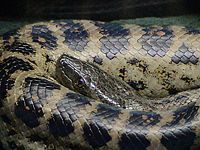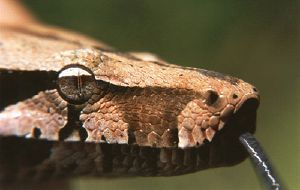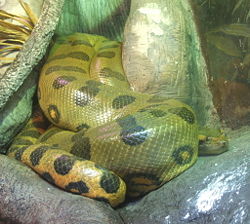Anaconda
| Anaconda | ||||||||||||||||
|---|---|---|---|---|---|---|---|---|---|---|---|---|---|---|---|---|
 Yellow Anaconda, Eunectes notaeus
| ||||||||||||||||
| Scientific classification | ||||||||||||||||
| ||||||||||||||||
|
E. beniensis |
Anaconda is the common term for any member of four species of semi-aquatic boas (Boidae family) of South America comprising the genus Eunectes. Like the related and similarly appearing pythons, they have two lungs and are constrictors that suffocate their prey by wrapping around it; however, in addition to various physical differences, pythons are found in the Old World and anacondas in the New World (SDZ 2007). Anacondas typically inhabit the swamps and rivers of the dense forests of tropical South America, although the yellow anaconda can be found as far south as Argentina and green anacondas can be found as far north as Trinidad, the southernmost island in the Caribbean.
Anacondas provide important ecological values, keeping the balance of nature by consuming rodents, fish, caimans, and even such mammals as capybaras, tapirs, and deer. For humans, they add to the fascination with nature and are even kept as pets.
There are two possible origins for the word "anaconda." It is perhaps an alteration of the Sinhalese word "henakanday," meaning "thunder snake," or alternatively, the Tamil word "anaikondran," which means "elephant killer." Metcalf (1999) notes that the name first was probably from the Sinhala language of Sri Lanka, formerly Ceylon, and that in 1869, the Englishman John Ray wrote of "anacandaia of the Ceylonese, i.e., he that crushes the limbs of the buffaloes and yoke beasts." For more than one hundred years the name was applied to a (python) snake from Ceylon, but in the nineteenth century experts began to use it for a snake residing in the Amazon basin; an 1849 British Museum Catalogue of Snakes lists "the Ancondo, Eunectes murimus, Brazil" (Metcalf 1999). It is unclear how the name originated so far from the snake's native habitat; it is likely due to its vague similarity to the large Asian pythons. Local names for the anaconda in South America include the Spanish term matatoro, meaning "bull killer," and the Native American terms sucuri, yakumama, and jibóia.
Overview
Anacondas comprise a genus of boas (one of twelve genera of boas, depending on the taxonomic scheme employed). Boas are a type of non-venomous snakes that are members of the Boidae family. Boas are basal snakes that are "primitive" in evolutionary terms (i.e. less derived). They are constrictors and most give birth to live young. They have anal spurs, a pair of claws on each side of the cloaca that assist in mating. Boas are named after cows (Latin: bos) because of the old myth that boa snakes pursue cows and suckle them until they are drained to death. Anacondas as members of the boa family are sometimes called water boas.
As constrictors, boas do not have venom in their fangs to kill prey; instead, they simply squeeze them to death. The snake initially strikes at its prey and holds on, pulling the prey into its coils or, in the case of very large prey, pulling itself onto the prey. The snake will then wrap one or two coils around the prey. Contrary to myth, the snake does not crush the prey, or even break its bones, but instead squeezes, tightening its grip to cut off circulation and preventing the lungs from expanding so that it suffocates. The snake can sense the prey's heartbeat and holds firm until the heart, deprived of oxygen, has stopped beating so that the prey will not recover and struggle while being swallowed. The snake then engulfs the prey.
Boas are similar in appearance and closely related to pythons, the common name for a group of non-venomous constricting snakes comprising the family Pythonidae. Both boas and pythons are considered to be primitive snakes, and both are constrictors. Both also have two lungs (most snakes have one lung) and have remnants of hind legs and pelvic bones (SDZ 2007). They are similar enough that some authorities actually place pythons as a subfamily (Pythoninae) within the boa family. Pythons are distinguishable from boas in that they have teeth on the premaxilla, a small bone at the very front and center of the upper jaw. Furthermore, while most boas produce live young, pythons produce eggs. Some species of sand boas (Ericinae) are also called python.
Boas typically are separated into two subfamilies: Boinae or true boas and Erycinae or sand boas. (Although, as noted above, pythons are sometimes classified as a subfamily of Boidae as well, but generally are listed under their own family, Pythonidae. Sand boas also are frequently listed under their own family, Erycidae.) The anacondas are placed within the subfamily Boinae.
Snakes of the subfamily Boinae are found in Madagascar, Papua, Pacific Islands, and the Neotropics. True boas are medium to large sized snakes. Females are usually larger than their males. Boas contain many subspecies based on locality. The boas from the Amazon Basin are the most colorful, possessing bright cherry red tails. It used to be said that boas were New World Snakes and pythons were Old World Snakes, but, with boas found on Madagascar, Fiji, and Solomon Islands, this is not quite true. Instead, it is possible that boas have survived in evolutionarily isolated areas. South America, until a few million years ago, had a distinct fauna that included marsupial mammals; with the land bridge to North America, boas have migrated north as placental mammals and colubrids have migrated south.
Genera placed within the subfamily Boinae are Boa (one species: boa constrictor); Acrantophis (Dumeril's boa and Madagascar ground boa; sometimes equated with boa); Sanzinia (Madagascar tree boa; sometimes equated with boa); Eunectes (anacondas); Corallus (tree boas); Epicrates (rainbow boas); and Candoia (Pacific boas).
Compared to true boas, snakes of the subfamily Erycinae are quite small, with most members remaining well under a meter in length. Fossil erycines have been found in rock strata over 50 million years old, and were once widespread in North America. Now, only two species remain in North America, as well as the sand boas in Africa, Asia, and southeastern Europe. At least three erycine species lay eggs: the Calabar boa, (Calabaria reinhardtii) (once classified as a python for this reason); the Arabian sand boa, (Eryx jayakari); and the West African sand boa, (Eryx muelleri). The genera placed within the subfamily Erycinae are Eryx (sand boas); Gongylophis (rough-tailed sand boa); Charina (rubber boas); Lichanura (rosy boa); and Calabarinae (calabar python).
Anaconda species
Four anaconda species have been identified:
- Bolivian anaconda, Eunectes beniensis
- Dark-spotted anaconda, Eunectes deschauenseei
- Green anaconda, Eunectes murinus
- Yellow anaconda, Eunectes notaeus
The green anaconda is the most well known, both because of size and wide distribution. It is found throughout the Amazon River Basin and the Orinoco River Basin and as far north as Trinidad. Often, anacondas are equated with the green anaconda. The yellow anaconda is the second most well known, located in southern Brazil, Bolivia, Paraguay, Uruguay, and northern Argentina. The Bolivian anaconda and the dark-spotted anaconda (also called de Schauensee's anaconda) are rare, little known, and of limited distribution, with the Bolivian anaconda endemic to Bolivia and the dark-spotted anaconda known on Ilha de Marajó, an island in the mouth of the Amazon River. Additional species may be delineated as more research is done in South America.
Anacondas feed on a variety of animals, generally caught in the water or nearby. Adult anacondas can capture capybaras, tapirs, caimans, deer, sheep, birds, and even jaguars. Fish, rodents, and amphibians may be captured by young anacondas.
Green anaconda
The green anaconda (Eunectes murinus) is the largest member of the boa family of snakes and the most heavy bodied member of the super-order Squamata.
The primary overall color of Eunectes murinus is an olive green, with black blotches that run the length of the body. Their head is narrow compared to the rest of the body, with most exhibiting distinctive orange-yellow striping on either side. Their eyes are set high on their head so as to allow the snake to be able to see out of the water without exposing the rest of its body; likewise the nostrils are set high so the animals can breathe while largely submerged.
Green anacondas are found mainly in northern South America (Amazon and Orinoco basins), in Venezuela, Colombia, Brazil, northern Bolivia, northeast Peru, Guyana, and the island of Trinidad.
The green anaconda is among the largest snakes in the world, with recorded (but unverified) measurements of 9.45 meters (29.7 feet) and 11 meters (33.5 feet). It rivals the reticulated python for length, but is typically considerably heavier. Females are significantly larger than males, having the largest sexual dimorphism of all the snakes.
Green anacondas, like all anacondas, are primarily aquatic. They eat a wide variety of prey, almost anything they can manage to overpower, including: fish, birds, a variety of mammals, and other reptiles. Particularly large anacondas may even consume large prey such as tapir, deer, capybara, caiman, and sometimes crocodiles and jaguars, but such large meals are not regularly consumed. They employ constriction to subdue their prey. Cannibalism among green anacondas is also known, most recorded cases involving a larger female consuming a smaller male. Scientists cite several possible reasons for this, including the dramatic sexual dimorphism in the species and the possibility that female anacondas require additional food intake after breeding to sustain their long gestation period and the male simply being an opportunistic prey item; however, the exact reason is not understood (Rivas and Owens 2000).
Anacondas are ovoviviparous. Copulation takes place during the rainy season, typically in the water. The spurs of the males are used to stimulate the females. Gestation is approximately six months. Litter size averages 20-40 young, but as many as 100 are possible. Sexual maturity is reached between two and three years of age.
Yellow anaconda
The yellow anaconda (Eunectes notaeus), is native in South America in countries including Bolivia, Paraguay, Uruguay, western Brazil, and northeast Argentina. It is smaller than the more well-known green anaconda and reaches an average adult length of about three meters (9.8 feet). They have a yellowish brown base color with black blotches and rosettes. They live in mostly aquatic habitats including swamps, marshes, and brush covered banks of slow-moving rivers and streams. Their diet includes deer, wild pigs, birds and large rodents and also aquatic animals such as fish.
Giant anacondas
There is some debate about the maximum size of anacondas, and there have been unverified claims of enormous snakes alleged to be as long as 30-45 meters (100-150 feet). One such report is of a 1944 petroleum expedition in Colombia that claimed to have shot and measured an 11.4 meter (37.5 feet) specimen (Krystek 1999). This claim is not always regarded as reliable, particularly since the expedition did not photograph or skin the snake, since they claimed it turned out not to be dead and crawled or swam away while they ate lunch. Perhaps a more credible report came from scientist Vincent Roth, who claimed to have shot and killed a 10.3 meter (34 feet) anaconda in Guyana (Krystek 1999).
There are some reports from early European explorers of the South American jungles seeing giant anacondas up to 18.2 meters (60 feet) long, and some of the native peoples have reported seeing anacondas up to 15.2 meters (50 feet) long (ES 2007), but these reports remain unverified. Another claim of an extraordinary size anaconda was made by adventurer Percy Fawcett. During his 1906 expedition, Fawcett wrote that he had shot an anaconda that measured some 18.9 meters (62 ft) from nose to tail (Justice 2007). Once published, Fawcett’s account was widely ridiculed. Decades later, Belgian zoologist Bernard Heuvelmans (1995) came to Fawcett's defense, arguing that Fawcett's writing was generally honest and reliable (TA 2007).
It should be noted that the Wildlife Conservation Society has, since the early twentieth century, offered a large cash reward for live delivery of any snake of 30 feet or more in length. The reward, first offered in the early 1900s by President Theodore Roosevelt at the amount of $1,000, has grown to $50,000. It has never been claimed. Also, in a study of 1000 wild anacondas in Brazil, the largest captured was 17 feet long (Gordon 2007). Snake skins over 30 feet long have been accurately measured, but can easily be stretched a quarter of the original length without distortion (Gordon 2007).
The Guinness Book of World Records holds the longest snake ever reliably measured to be a 39.4 foot reticulated python (Python reticulatus), slain in 1912 on the Indonesian island of Sulawesi (Gordon 2007). Anacondas are generally held to be heavier, albeit not a long as reticulated pythons.
ReferencesISBN links support NWE through referral fees
- Extreme Science (ES). 2007. Which is the biggest snake?. Extreme Science.
- Gordon, D. G. 2007. The search for the $50,000 snake. Encarta. Retrieved August 22, 2007.
- Heuvelmans, B. 1995. On the Track of Unknown Animals. London: Kegan Paul International. ISBN 0710304986
- Justice, A. 2007. Sucuriju gigante. Cryptozoology. Retrieved August 22, 2007.
- Krystek, L. 1999. Big snakes. The Museum of Unnatural Mystery. Retrieved August 22, 2007.
- Metcalf, A. A. 1999. The World in so Many Words: A Country-by-country Tour of Words That Have Shaped our Language. Boston: Houghton Mifflin. ISBN 0395959209
- Rivas, J. A., and R. Y Owens. 2000. Eunectes murinus (Green anaconda): Cannibalism. Herpetological Review 31: (In press). Retrieved August 22, 2007.
- San Diego Zoo (SDZ). 2007. Reptiles: Boa. San Diego Zoo's Animal Bytes. Retrieved August 22,2007.
- True Authority (TA). 2007. Giant anaconda, Amazon, South America. True Authority. Retrieved August 22, 2007.
External links
All links retrieved July 26, 2023.
Credits
New World Encyclopedia writers and editors rewrote and completed the Wikipedia article in accordance with New World Encyclopedia standards. This article abides by terms of the Creative Commons CC-by-sa 3.0 License (CC-by-sa), which may be used and disseminated with proper attribution. Credit is due under the terms of this license that can reference both the New World Encyclopedia contributors and the selfless volunteer contributors of the Wikimedia Foundation. To cite this article click here for a list of acceptable citing formats.The history of earlier contributions by wikipedians is accessible to researchers here:
- Anaconda  history
- Boa  history
- Green_Anaconda  history
- Constriction  history
- Yellow_anaconda  history
The history of this article since it was imported to New World Encyclopedia:
Note: Some restrictions may apply to use of individual images which are separately licensed.


